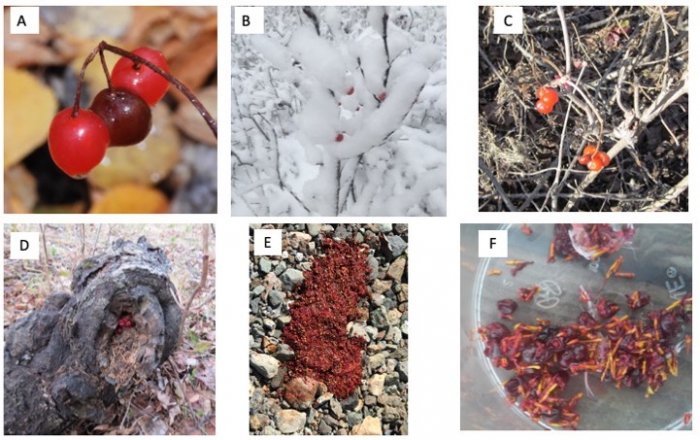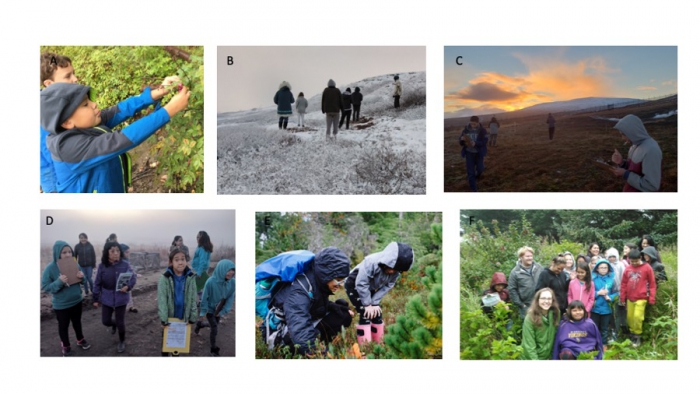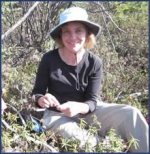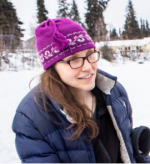By: Christa P.H. Mulder, Katie V. Spellman, and Elena Sparrow, University of Alaska Fairbanks.
In the far north, many plant species retain their fruits into the fall and throughout the winter. Fleshy fruits provide a high-quality food source at a time when few other resources are available and are an important component of the late fall, early winter, and spring diets of Arctic and boreal animals such as voles, foxes, bears, geese, and grouse. Fleshy fruits ("berries") are also of great cultural and nutritional importance to rural and Indigenous communities across the Arctic. Warmer springs are leading to earlier flowering and fruiting (e.g., Parmesan and Yohe 2003, Mulder and Spellman 2019). Will earlier fruit ripening combined with longer falls result in earlier loss of fruits to consumers? Will a greater proportion of fruits be lost to decomposers? These questions, and the lack of basic natural history on fruit retention, drove the establishment of Winterberry, an Alaska-wide citizen science network funded by the National Science Foundation and supported by the Bonanza Creek Long Term Ecological Research Site.


Over 1,500 volunteers (primarily youth in schools or after-school programs plus some adult volunteers) in 45 sites in 25 communities across six ecoregions of Alaska collected data on fruit retention. Each group focused on one of four species: Rosa acicularis (prickly rose), Viburnum edule (highbush cranberry), Vaccinium vitis-idaea (lingonberry or lowbush cranberry) and Empetrum nigrum (crowberry). We selected these four species because they are abundant, widely distributed, and important to the people and animals of the far north. Participants monitored approximately 20 plants and counted the number of unripe, ripe, rotten, dry and damaged fruits throughout the fall until snowfall, and again following snow melt. Youth analyzed their data during "data jams" with scientists; they also participated in a range of activities like making berry treats that they shared with elders, expressing what berries meant to them via community storytelling nights and story landscapes, and using their data to imagine possible futures for berry stewardship (Figure 3).

We have evaluated data from four years (fall 2016–spring 2020) for differences between ecoregions, changes in fruit loss over the course of the fall, and changes in the proportion of fruits that are "healthy" (not rotten or dry or damaged) between seasons. We found that, in general, fruit loss occurred earlier in the more northern ecoregions of Alaska (e.g., interior Alaska, and along the west coast) than in the regions further south (e.g., south of the Alaska range, including the Aleutians and coastal rainforest). By the time of snowfall, most sites had lost 50–75% of their fruits, though in the coastal rainforest sites losses were generally lower. Over the course of the fall, the number of fruits lost per week declined but the proportion of fruits lost was constant. Rates of fruit loss (% fruits per unit time) were similar for fall and spring but much lower in winter; despite this, some fruits continued to be lost throughout the winter. As expected, the two species that were not completely covered by snow, prickly rose and highbush cranberry, showed a bigger difference between fall and winter than the short-statured crowberry, but for short-statured lingonberry the differences were similar to those of the taller species. Fruits that were rotten or dry were lost from plants at higher rates than "healthy" fruits.
The high retention rate and constant loss rates per fruit in fall and winter suggest that fruit retention is a component of the life history strategy of these species, analogous to the retention of leaves in evergreen plants. Fruit retention may reduce competition for fruit dispersers, which may be especially important in regions where due to the short growth season, fruits of many species ripen during the same short time period. Our results suggest that earlier ripening in a warming climate will lead to a lower proportion of fruits on the plants at the time of snowfall, reducing winter and spring fruit availability. However, the finding that a portion of fruits are still on the plant in the spring suggests that animals migrating north in the springtime may be able to move seeds of genotypes adapted to warmer conditions to higher latitudes, which may be beneficial as Arctic and boreal regions continue to warm. Next, we plan to look at the extent to which interannual variation can be explained by environmental conditions across the landscape, and predict what will happen to fruits under continued climate change.
More information about the Winterberry project and out how to join our efforts is on the Winterberry website. Or, contact Christa Mulder, (cpmulder [at] alaska.edu) or by phone (+1 907-474-7703).
References
Mulder, C. P. H., and K. V. Spellman. 2019. Do longer growing seasons give introduced plants an advantage over native plants in Interior Alaska? Botany 97:347-362.
Parmesan, C., and G. Yohe. 2003. A globally coherent fingerprint of climate change impacts across natural systems. Nature 421:37-42.
About the Authors
 Christa Mulder is a Professor of Ecology in the Department of Biology and Wildlife and the Institute of Arctic Biology at the University of Alaska Fairbanks. She is interested in plant phenology in the context of climate change, including changes in plant-animal interactions. She is also passionate about involving underrepresented groups, especially youth, in science.
Christa Mulder is a Professor of Ecology in the Department of Biology and Wildlife and the Institute of Arctic Biology at the University of Alaska Fairbanks. She is interested in plant phenology in the context of climate change, including changes in plant-animal interactions. She is also passionate about involving underrepresented groups, especially youth, in science.
 Katie Spellman is an Assistant Professor at the International Arctic Research Center at the University of Alaska Fairbanks. She is a life-long Alaskan who splits her research evenly between plant ecology and education research, with a focus on citizen science in a rapidly changing climate as a focus area at the interface of the two disciplines. She is dedicated to empowering diverse youth to address climate issues in their community through science.
Katie Spellman is an Assistant Professor at the International Arctic Research Center at the University of Alaska Fairbanks. She is a life-long Alaskan who splits her research evenly between plant ecology and education research, with a focus on citizen science in a rapidly changing climate as a focus area at the interface of the two disciplines. She is dedicated to empowering diverse youth to address climate issues in their community through science.
 Elena Bautista Sparrow, PhD, is Director of Education and Outreach at the International Arctic Research Center and a Research Professor of Soil Microbiology in the Department of Natural Resources and Environment at the University of Alaska Fairbanks. In a project exploring the impacts and feedbacks of a warming Arctic, she and her team (including co-authors) engage youth, educators, youth leaders, and community members in braiding multiple ways of knowing and observing climate change from Elders, satellites, and on-the-ground observations using GLOBE and methods developed in this winterberry project.
Elena Bautista Sparrow, PhD, is Director of Education and Outreach at the International Arctic Research Center and a Research Professor of Soil Microbiology in the Department of Natural Resources and Environment at the University of Alaska Fairbanks. In a project exploring the impacts and feedbacks of a warming Arctic, she and her team (including co-authors) engage youth, educators, youth leaders, and community members in braiding multiple ways of knowing and observing climate change from Elders, satellites, and on-the-ground observations using GLOBE and methods developed in this winterberry project.
